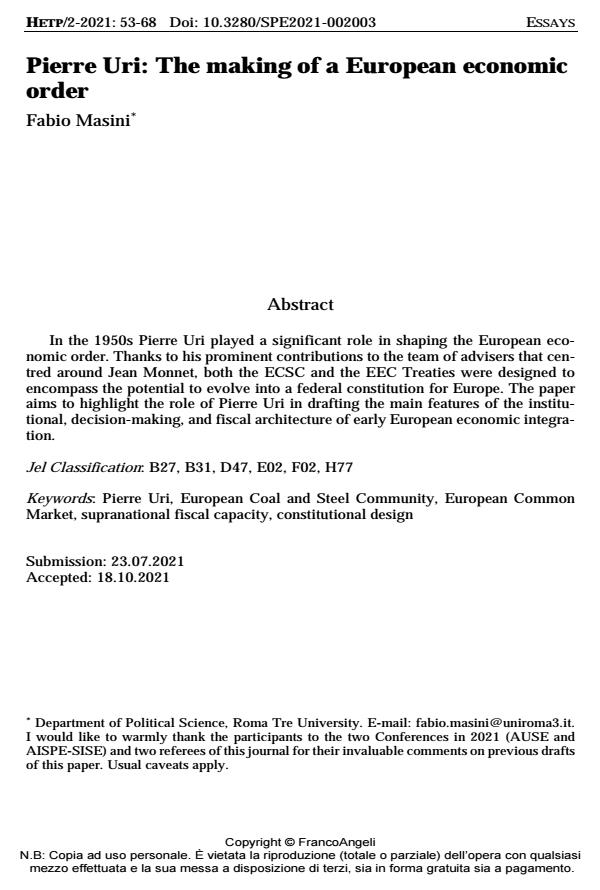Pierre Uri: The making of a European economic order
Titolo Rivista HISTORY OF ECONOMIC THOUGHT AND POLICY
Autori/Curatori Fabio Masini
Anno di pubblicazione 2022 Fascicolo 2021/2 Lingua Inglese
Numero pagine 16 P. 53-78 Dimensione file 65 KB
DOI 10.3280/SPE2021-002003
Il DOI è il codice a barre della proprietà intellettuale: per saperne di più
clicca qui
Qui sotto puoi vedere in anteprima la prima pagina di questo articolo.
Se questo articolo ti interessa, lo puoi acquistare (e scaricare in formato pdf) seguendo le facili indicazioni per acquistare il download credit. Acquista Download Credits per scaricare questo Articolo in formato PDF

FrancoAngeli è membro della Publishers International Linking Association, Inc (PILA)associazione indipendente e non profit per facilitare (attraverso i servizi tecnologici implementati da CrossRef.org) l’accesso degli studiosi ai contenuti digitali nelle pubblicazioni professionali e scientifiche
In the 1950s Pierre Uri played a significant role in shaping the European eco-nomic order. Thanks to his prominent contributions to the team of advisers that centred around Jean Monnet, both the ECSC and the EEC Treaties were designed to encompass the potential to evolve into a federal constitution for Europe. The paper aims to highlight the role of Pierre Uri in drafting the main features of the institutional, decision-making, and fiscal architecture of early European economic integration.
Keywords:Pierre Uri, European Coal and Steel Community, European Common Market, su-pranational fiscal capacity, constitutional design
Jel codes:B27, B31, D47, E02, F02, H77
- Beaud M. and Dostaler G. (1993). Economic Thought Since Keynes. A History and Dictionary of Major Economists, London, Routledge.
- Burgess M. (2000). Federalism and European Union: The Building of Europe, 1950-2000, London, Routledge.
- Clark J.M., Smithies A., Kaldor N., Uri P. and Walker R.E. (1949). National and International Measures for Full Employment, Report by a Group of Experts appointed by the Secretary General, United Nations, Department of Economic Affairs, United Nations publication, New York, E/1584, Dec. 22.
- Clerc D. (2007). A che cosa servono gli economisti? Alternatives économiques, 73(1).
- Cohen R. (1992). Pierre Uri, 80, a Chief Architect of European Community Treaties, The New York Times, July 24, Section D, Page 17.
- Connell, C.M. (2012). Reviving Confidence, Journal of the History of Economic Thought, 34(3): 293-320.
- Dangel-Hagnauer C., Raybaut A. (2007). French Economists within Public Institutions: The Making of Economic Policy in Post-Second-World-War France. In Asso P.F., Fiorito L. (eds.). Economics and Institutions. Contributions from the History of Economic Thought. Selected Papers from the 8th Aispe Conference, Milano, FrancoAngeli, pp. 163-185.
- Dedman M.J. (2006). The Origins and Development of the European Union. A History of European Integration, London, Routledge.
- Denord F. and Schwartz A. (2010). L’économie (très) politique du traité de Rome, Politix, 1(89): 35-56.
- Dyson K. and Maes I. (2016). Architects of the Euro. Intellectuals in the Making of European Monetary Union, Oxford, Oxford University Press.
- Gerbet P. (1991). P. Uri: Penser pour l’action, un fondateur de l’Europe; C. Pineau, C. Rimbaud: Le grand pari, l’aventure du Traité de Rome; E. Serra: II rilancio dell’Europa e i Trattati di Roma; H.J. Küsters: Fondements de la Communauté économique européenne, Revue française de science politique, 41(6): 835-837.
- Gillingham J. (2003). European Integration 1950-2003. Superstate or New Market Economy?, Cambridge, Cambridge University Press.
- Gioli G. (ed.) (1997). L’Europa e gli economisti italiani nel Novecento. Federalismo, integrazione economica, fiscalità, Milano, Franco Angeli.
- Machlup F. (1977). A History of Thought on Economic Integration, London, Macmillan.
- Maes I. (2021). Robert Triffin. A Life, New York, Oxford University Press.
- MacDougall D. (ed) (1977). Report of the Study Group on the Role of Public Finance in European Integration, Brussels, European Commission.
- Melchionni M.G., Ducci R. (eds) (2007). La genèse des traités de Rome. Entretiens inédits avec 18 acteurs et témoins de la négociation, Paris, Economica.
- Milward A.S. (1992). The European Rescue of the Nation State, London, Routledge.
- Monnet J. (1978). Memoirs, New York, Doubleday.
- Padoa-Schioppa T. (2001). Europa, forza gentile, Bologna, il Mulino.
- Spaak P.H. (1956). Rapport des Chefs de Délégation aux Ministres des Affaires Étrangères, Brussels, Comité intergouvernemental crée par la conférence de Messine, April 21.
- Triffin R. (1957). Europe and the Money Muddle. From Bilateralism to Near-Convertibility, 1947-1956, New Haven, Yale University Press.
- [Uri, Pierre] Europeus (1959). La crise de la zone de libre échange, Tribune Libre.
- Uri P. (1973). Dialogue Not Dispute: GATT Talks Focus US-EC Relations, European Community, Oct, 17-18.
- Uri P. (1989). Fragments de politique economique. Les libertés de la function publique. Les servitudes de la dispersion, Paris, Presses Universitaires de Grenoble.
- Uri P. (1991). Penser pour l’action: un fondateur de l’Europe, Paris, Éditions Odile Jacob.
- Warlouzet L. (2010). Le choix de la CEE par la France. L’Europe économique en débat de Mendès France à de Gaulle (1955-1969), Paris, Comité pour l’histoire économique et financière de la France.
- Italy, 1982: the case for Ecu-denominated Treasury bonds Fabio Masini, Albertina Nania, in The European Journal of the History of Economic Thought /2024 pp.1
DOI: 10.1080/09672567.2024.2329053
Fabio Masini, Pierre Uri: The making of a European economic order in "HISTORY OF ECONOMIC THOUGHT AND POLICY" 2/2021, pp 53-78, DOI: 10.3280/SPE2021-002003